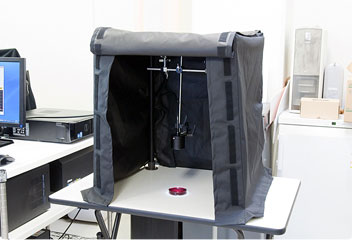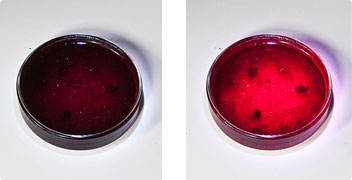Research equipment for investigating the science of visual perception
What kind of equipment are you using in your research?

The ELS-VIS "Equalized Light Source + Visible"
We are using equipment such as electro-encephalographs and transcranial magnetic-stimulation devices to measure brain activity. To measure light, we are also using a wide-ranging assortment of light spectrophotometers and spectral-imaging systems, for all the different wavelengths we are dealing with. This array of world-class spectral-image measurement apparatus enables us to measure a wide spectrum of wavelengths, ranging from 350 nanometers to 2500 nanometers.
Our research doesn't only require measurement equipment, however. We also need a device that radiates light at wavelengths which are required for our particular purposes. The ELS-VIS "Equalized Light Source + Visible" fulfils this need. Prior to our adoption of the ELS-VIS, we had to develop a separate device for each light wavelength that we needed, and this consumed considerable time and effort. However, with the adoption of the ELS-VIS, which can generate light at various wavelengths, this hardship has disappeared.
Although we use a wide variety of light measurement devices, we rely solely on the ELS-VIS for generating light.
What were the circumstances that led to the adoption of the ELS-VIS?

An example screen from the accompanying software. Operation is intuitive—for example, the user can adjust the spectrum using the same type of equalizer found on audio equipment and set the output by clicking on the chromaticity diagram.
The ELS-VIS "Equalized Light Source + Visible" was exhibited at a conference held in May 2009. I felt that the notion of a variable light source, a single device which (unlike existing light sources) could generate multiple wavelengths, was extremely interesting, and immediately sought out the engineers to hear what they had to say.
At the time there were two other commercially available devices (both foreign products) that could be programmed to generate variable-wavelength light. However, neither they nor the ELS-VIS satisfied my usage requirements. What I really needed was a light source which would enable me to expose a target object to a specified type of light and to assess how human beings would perceive it, and which could be used as an illumination simulator that would allow operations such as visual inspection. Since there would inevitably be a certain distance between the light source and the target object, none of the available light sources was sufficiently powerful. When I consulted the ELS-VIS engineers about this, they were prepared to discuss possible improvements in a purely non-business context. As a result, I told them that if they could increase the initial power from 300 W to 800 W, I would buy one of their devices.
It seems that increasing the light source's power was no easy task, however—the power supply, cooling, and cables all had to be reworked and I heard that the Nikon engineers went to considerable trouble to do all this. In this fashion they completed a customized version of the ELS-VIS in line with my requests, and we began using it in November 2009.
Please describe a device that you have produced using the ELS-VIS.
We used ELS-VIS in the development of the device used for identifying foreign substances which get mixed into blueberry jam, which I mentioned earlier. Since blueberry jam is dark in color, any foreign substances (such as twigs or pebbles) that get mixed into it will get stained the same color as the jam, making them very difficult to discern. When the device generates light of a specified wavelength, the light penetrates the blueberry jam, making the foreign substances stand out and thus enabling them to be identified visually.
The first step in the development process was to ascertain the white-light wavelengths that would be suitable to serve as functional light. A computer simulation was used to select from among several hundred thousand wavelength combinations. For confirmation purposes light at these wavelengths was then generated for real using the ELS-VIS, and the wavelengths to be used were specified. A light source that emitted functional light at the specified wavelengths was then developed and incorporated into the device.
This light source consists of an LED. Although LEDs are renowned simply for having long lifespans and consuming little power, they also, in fact, boast the characteristic of being able to generate light at a variety of wavelengths. Since they can produce various types of illumination comprised of white light, which (although they appear identical to the human eye) have different functions that suit specific applications, LEDs are also ideal for generating functional light.

Light source device for assisting in the detection of foreign bodies in blueberry jam

Left: Viewed in ordinary light
Right: Exposed to functional illumination
As shown above, when the blueberry jam is exposed to functional illumination, it will appear to be a different color and any foreign bodies will stand out.

